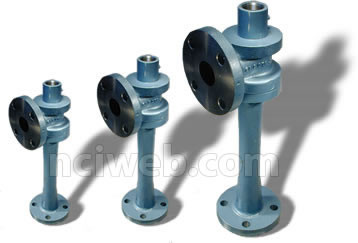|
 Jet Compressors are used in the process, paper, petroleum, power, gas, and other industries to circulate steam, boost low-pressure steam, and to mix, transfer, and compress gases. Jet Compressors are used in the process, paper, petroleum, power, gas, and other industries to circulate steam, boost low-pressure steam, and to mix, transfer, and compress gases.
A jet compressor is a type of ejector which utilizes a jet of high-pressure gas as an operating medium to entrain a low-pressure gas, mix the two, and discharge at an intermediate pressure. Gases can be steam, air, propane, or others. When both motive and suction gases are steam, the compressor is generally referred to as a "thermocompressor."
Construction & Operation: They consist of three basic parts, namely: a nozzle, a body, and a diffuser. Fig. 1 identifies these parts and illustrates design and operation.
Jet compressors can be supplied in materials to meet service conditions. Standard materials and components are noted in each section.
Design of the nozzle follows basic thermodynamic laws. Design of the diffuser, however, is still partially empirical. For this reason, S&K's long experience in designing, manufacturing, and testing jet compressors can be very helpful.
The motive gas, under pressure, enters the compressor and flows through the nozzle. The nozzle converts the high-pressure gas into a high velocity jet stream which creates a suction and causes entrainment of the low-pressure gas. The motive and suction gases are mixed in the body. The diffuser then converts the velocity head of the gas mixture to static head so that proper discharge pressure can be obtained.
When required, a steam jacket can be applied on the nozzle and diffuser of the compressor since, in some applications, freezing can occur. A typical example would be a case where natural gas is supplied to the nozzle at 60'F and due to expansion is reduced in temperature to below O 'F at the outlet of the compressor nozzle.
|
Compared with other types of compressing equipment, jet compressors offer definite advantages. Some of these are as follows:
- Jet compressors are simple in construction, have no rapidly rotating parts to break, get out of order, adjust, or replace.
- Jet compressors can be made from practically any machinable material-cast iron, bronze, special stainless steels, etc.
- Since they require little attention, they can be installed in remote locations.
- These compressors can be used in potentially explosive atmospheres without additional safeguards because they have no electrical components.
- The jet compressor not only performs the primary function of compressing and mixing gases but, in addition, it takes the place of a reducing valve and salvages much of the energy lost in the reduction of operating medium pressure.
- Compared with other types of equipment, jet compressors are very low in original cost and in upkeep.
|
|
Types and sizes of S&K Jet Compressors are listed in the following pages. Types include the following: fixed nozzle type compressors; compressors with manually controlled spindle; compressors with automaticallycontrolled spindle.
Fixed-nozzle type jet compressors are suitable for applications as noted on page 3 where conditions are such that no controls whatever are required, or where use of several compressors in parallel will permit an adequate degree of control.
Normally, some form of flow regulation is required.
|